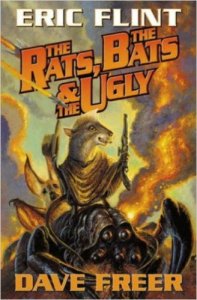Rats, Bats & Vats / The Rats, the Bats, & the Ugly – book reviews by Fred Patten.
by Patch O'Furr
Submitted by Fred Patten
Fred writes: a few reviews of furry books that I wrote in 2003 or 2004 have vanished from the Internet. I wrote them for the first version of Watts Martin’s Claw & Quill site, which he has apparently taken down. Here they are back online.
 Rats, Bats & Vats, by Dave Freer & Eric Flint. Maps by Randy Asplund.
Rats, Bats & Vats, by Dave Freer & Eric Flint. Maps by Randy Asplund.
Riverdale, NY, Baen Books, September 2000, hardcover $23.00 (388 pages), Kindle $6.99; September 2001, paperback $7.99 (448 pages).
The Rats, the Bats, & the Ugly, by Eric Flint & Dave Freer. Maps by Randy Asplund.
Riverdale, NY, Baen Books, September 2004, hardcover $24.00 (391 pages), Kindle $6.99.
I had intended to review just the latter “sequel”. But it is such a close continuation of the former that to read RBU alone is like starting an 800-page novel in the middle. The introductory synopsis is adequate, but it is much more enjoyable to read the whole story.
Harmony and Reason is a colony planet founded on utopian ideals, which has evolved into a split between an elite upper class of founding Shareholders and an oppressed labor class of cloned “Vats”. Unknown aliens, the sea-urchinlike Korozhet, come to HAR to warn that it is about to be conquered by still other aliens, the brutal insectlike Magh’ empire. But the friendly Korozhet will share their superior technology with the humans to help them defend themselves. Among this technology are soft-cyber implants (brain chips) to increase the intelligence of animals. The two species of animal soldiers that HAR bioengineers are bats, for flying explosive devices into Magh’ camps, and “rats” (actually a bioengineered cross between rats and elephant shrews) which make fanatically vicious commandos.
It does not take long for the front-line troops to realize that the Korozhet are not the benevolent saviors they claim to be. They have engineered the Magh’ invasion to whittle down HAR’s defenses so they can safely conquer it for themselves. The creation of the bats and rats is to develop new cyber-controlled slave species. But by then, the Korozhet have gained psychological control over the incompetent Military High Command. To complicate matters, neither the Korozhet nor most humans realize that the bats and rats are more than just computer-guided cannon fodder. They are truly intelligent and are each planning their own revolt.
This may sound dramatic, but the two-volume novel is mostly a military-political s-f comedy. Much action revolves around the evasions that the front-line troops use to get around the stupidly suicidal orders from the pompous High Command so they can effectively battle the Magh’.
The main story follows Private Charles “Chip” Connolly, a Vat-bred conscript, and the handful of rat and bat soldiers who get to know each other when they are trapped behind Magh’ lines. Their friendship evolves into a popular front to unite the rats, bats and Vats at the same time that they save all HAR from the Korozhet and the Magh’.
The bats have taken human revolutionaries as their role models:
“Fluttering along behind Connolly, Michaela Bronstein tried to formulate strategy. Revolution! Throwing off the cruel yoke of human oppression! Liberty, equality and belfry! […] Of course, bats, by their very nature, had always chittered and argued about how liberation should be achieved. Eamon Dzhugashvilli was one of the notorious Bat Bund who had advocated straight and bloody murder, blowing every non-bat to kingdom come with as much high explosive as they could lay their claws on, and allying batdom with humankind’s foes.” (pg. 24)
The rats are even more anarchistic, and much more individualistic. An increase in intelligence has not changed their interest in not much besides food and sex, except to make them aware of alcohol. A rat community seems at first glance to be little different from a non-stop drunken orgy:
 “‘Hello handsome,’ said the rattess who was supporting the ornamental light on the cornice. Unless Fluff’s eyes deceived him, she was wearing what looked like black fishnet stockings. ‘If you hath the money, I hath the time.'” (pg. 238)
“‘Hello handsome,’ said the rattess who was supporting the ornamental light on the cornice. Unless Fluff’s eyes deceived him, she was wearing what looked like black fishnet stockings. ‘If you hath the money, I hath the time.'” (pg. 238)
Fluff — full name: Don Juan el Magnifico de Gigantico de Immaculata Conception y Major de Todos Saavedra Quixote de la Mancha — is a seven-inch tall galago, a lemurlike primate. He is the only uplift of his kind, a pet manufactured for a Shareholder’s daughter. It amused the Shareholders to give him the personality of a Don Quixote. But Fluff is no fool, and he uses his tiny size and arboreal abilities to aid the Good Guys. If Rats, Bats and Vats had not been published in 2000, almost four years before Shrek 2, Fluff would have looked like a shameless imitation of its Spanish-caballero Puss in Boots.
This two-volume novel, both with amusing covers by Bob Eggleton, is only about 50% anthropomorphic. But that 50%, about how Chip, other humans, and the animals propose to blend “normal” humans, high-strung bats and hedonistic rats into a joint society, is enough to put it onto any anthropomorphic reading list.
Please note that the order of the co-authors’ names is reversed on the second title. They may not be filed together in bookshops and libraries.

